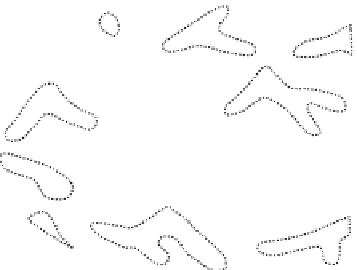Environmental Engineering Reference
In-Depth Information
Mixed
layer
Tiered
transition
layer
Historical
layer
ichnofabric
FIGURE 2
Burrow stratigraphy in carbonate ooze and resulting ichnofabric preserved in the
stratigraphic record.
Ekdale et al., 1984a
). In these substrates, active bioturbation occurs in two
layers; a surface mixed layer and a transition layer (
Fig. 2
). The surface mixed
layer is a zone of rapid and continuous homogenization by epibenthic and shal-
low endobenthic animals. As revealed by sea-floor photographs and in the tops
of box cores, these organisms may produce surface tracks and trails, as well as
endogenic locomotion, dwelling, feeding, and gardening structures, including
graphoglyptids—for example,
Cosmorhaphe
,
Spirorhaphe
, and
Paleodictyon
(e.g.,
Ekdale et al., 1984a
: fig. 7;
Gaillard, 1991
). The transition layer, the thick-
ness of which varies as a function of environmental factors, is a zone of hetero-
geneous mixing by organisms that live or feed at greater depths in the substrate.
Transition-layer organisms produce suites of endogenic traces that may include
open and actively filled burrows or burrow systems, as well as complex sprei-
ten. Notably, the preservation potential of distinct mixed-layer traces is very
low. Because mixed-layer sediments are more fluid, open burrows produced
therein may collapse shortly after formation, and those that are actively or pas-
sively filled may be compacted beyond recognition. Moreover, surface traces
and shallow endogenic structures are subsequently overprinted by transition-
layer structures as the zone of active bioturbation migrates slowly upward in
pace with sedimentation. Hence, ichnofabrics preserved in the stratigraphic























































































































































Search WWH ::

Custom Search